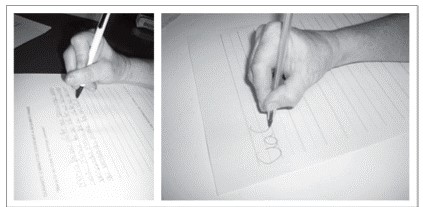
INTRODUCTION:
Writer’s cramp, also called mogigraphia and scrivener’s palsy, causes a cramp or spasm affecting certain muscles of the hand and/or fingers. Writer’s cramp is a task-specific focal dystonia of the hand. ‘Focal’ refers to the symptoms being limited to one location, and ‘task-specific’ means that symptoms first occur only when the individual engages in a particular activity. Writer’s cramp first affects an individual by inhibiting their ability to write.
CAUSES:
Although the etiology of writer’s cramp is not well known, it was historically believed to be the result of excessive fine motor activity, possibly complicated by a tense or otherwise inappropriate writing technique.
• Writer’s cramp frequently affects persons who write a great deal or perform other repetitive hand movements such as typing.
• Approximately 5% of patients have a positive family history of a similar condition.
• Five to ten percent report an accident or injury to the hand or arm immediately preceding the onset of symptoms.
• Several possible, but rare, associations have been reported, including C6 ruptured disk, lithium use, basal ganglia or cortical tumors, arteriovenous malformations (AVMs), and stroke. However, most cases are idiopathic.
CLINICAL FEATURE:
- Early symptoms may include loss of precision muscle coordination (sometimes first manifested in declining penmanship, frequent small injuries to the hands, dropped items and a noticeable increase in dropped or chipped dishes).
- cramping pain with sustained use and trembling.
- Significant muscle pain and cramping may result from very minor exertions like holding a book and turning pages.
- It may become difficult to find a comfortable position for arms and legs with even the minor exertions associated with holding arms crossed causing significant pain similar to restless leg syndrome.
- Affected persons may notice trembling in the diaphragm while breathing, or the need to place hands in pockets, under legs while sitting or under pillows while sleeping to keep them still and to reduce pain.
- Trembling in the jaw may be felt and heard while lying down, and the constant movement to avoid pain may result in the grinding and wearing down of teeth.
- The voice may crack frequently or become harsh, triggering frequent throat clearing. Swallowing can become difficult and accompanied by painful cramping
The symptoms worsen significantly with use, especially in the case of focal dystonia, and a “mirror effect” is often observed in other body parts: use of the right hand may cause pain and cramping in that hand as well as in the other hand and legs that were not being used. Stress, anxiety, lack of sleep, sustained use and cold temperatures can worsen symptoms.
DIAGNOSIS:
Electrical sensors (EMG) inserted into affected muscle groups, while painful, can provide a definitive diagnosis by showing pulsating nerve signals being transmitted to the muscles even when they are at rest. The brain appears to signal portions of fibers within the affected muscle groups at a firing speed of about 10 Hz causing them to pulsate, tremble and contort. When called upon to perform an intentional activity, the muscles fatigue very quickly and some portions of the muscle groups do not respond (causing weakness) while other portions over-respond or become rigid (causing micro-tears under load).
Imaging Studies
MRI – If a structural lesion is suspected
Procedures
Electromyography/nerve conduction studies
To evaluate for nerve injury, if trauma is the suspected cause
Confirm diagnosis by showing simultaneous contraction of agonist and antagonist muscles
MEDICAL MANAGEMENT:
Several classes of drugs have been used in patients with writer’s cramp. Anticholinergics have had conflicting results. Beta-blockers have helped the tremor in a few patients. Botulinum toxin injections seem to have the best results.
Anticholinergic
Blocking cholinergic innervation of the basal ganglia is hypothesized to increase the dopaminergic effect, thereby reducing dystonia.
At Physioline, Writer’s Cramp is treated with “COMBINATION THERAPY“
The Combination Therapy of Physioline is known to enhance the quality of life to maximum extent.
PHYSIOLINE PHYSIOTHERAPY TREATMENT HAS VITAL ROLE TO PLAY:
At Physioline, all the members of the rehabilitation team work together so as to provide proper care and the therapy in order to:
- Pain relief using Combination Therapy
- Muscle strengthening
- Massage (kneading) to break adhesions
- Transcutaneous electrical nerve stimulation (TENS) delivered to the forearm flexor muscles for a 2-week period has been found to improve symptoms for up to 3 weeks after treatment. Also other innovations of Combination therapy.
- Behavioral changes may help.
- Biofeedback, hypnotherapy, and relaxation therapy.
- Altering the grip of the pen and/or increasing the diameter of the pen used is the first step in treatment.
- Patients can use a writing device or other means of transcription, such as typing or dictation.
